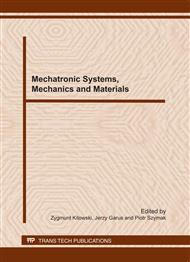[1]
P.J. Craven, R. Sutton and R.S. Burns: Control Strategies for Unmanned Underwater Vehicles in Journal of Navigation, Vol. 51, No. 2, (1998), pp.79-105.
DOI: 10.1017/s0373463397007601
Google Scholar
[2]
T.I. Fossen: Guidance and Control of Ocean Vehicles. John Wiley and Sons, Chichester (1994).
Google Scholar
[3]
T.I. Fossen: Marine Control Systems. Marine Cybernetics AS, Trondheim (2002).
Google Scholar
[4]
F. Song, P.E. An and A. Folleco: Modelling and Simulation of Autonomous Underwater Vehicles: Design and Implementation in IEEE Journal of Oceanic Engineering, Vol. 28, No. 2, (2003), pp.283-296.
DOI: 10.1109/joe.2003.811893
Google Scholar
[5]
J. Evans and M. Nahon: Dynamics Modelling and Performance Evaluation of an Autonomous Uunderwater Vehicle in Ocean Engineering, Vol. 31, No. 14, (2004), pp.1835-1858.
DOI: 10.1016/j.oceaneng.2004.02.006
Google Scholar
[6]
J. Garus: Adaptive Track-Keeping Control of Underwater Robotic Vehicle in International Journal of Mathematical Models and Methods in Applied Sciences, Vol. 1, No. 4, (2007), pp.217-222.
Google Scholar
[7]
A.J. Healey, S.M. Rock, S. Cody, D. Miles and J.P. Brown: Toward an Improved Understanding of Thruster Dynamics for Underwater Vehicles in IEEE Journal Oceanic Engineering, Vol. 20, No. 3, (1005), pp.354-361.
DOI: 10.1109/48.468242
Google Scholar
[8]
O.J. Sordelen: Optimum Thrust Allocation for Marine Vessels in Control Engineering Practice, Vol. 5, No. 9, (1997), pp.1223-1231.
Google Scholar
[9]
J. Garus: Optimization of Thrust Allocation in Propulsion System of Underwater Vehicle in International Journal of Applied Mathematics and Computer Science, Vol. 14, No. 4, (2004), pp.461-467.
Google Scholar
[10]
N. Ahmed and K.R. Rao: Orthogonal Transforms for Digital Signal Processing. Springer-Verlag, Berlin (1975). Appendix 1 Technical specification of the SUV. External dimensions: 1. length – 1.40 m 2. width – 0.36 m 3. height – 0.36 m Mass – 45.0 kg Buoyancy – 1.0 N to 2.0 N Operating depth – 200 m Maximum speed – 3 m/s Range – 500 m Propulsion: 1. roll axis thrusters – four thrusters, 3 blade screw thrusters, electrically driven, each 50 W power 2. vertical axes thruster – single thruster, electrically driven 3 blade screw propeller in tunnel, 50 W power Mission duration time – 30 minutes Energy source – lithium ion accumulator battery Control – remote, computer aided, using single optical fibre of 2000 m length
Google Scholar


